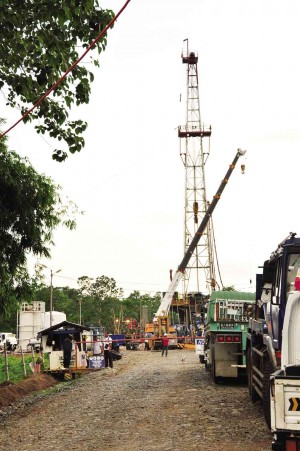Gas find brings hope to Isabela folk
SANTIAGO CITY—Livestock farmer Raymundo Rivera, 65, was not upset about the drilling at a lot across the road from his house in Barangay Balintocatoc here, except to complain about the noise.
“We don’t really mind the drilling noise that much. We have learned to adjust,” Rivera said, referring to the drill site of the state-owned Philippine National Oil Co.-Exploration Corp. (PNOC-EC), which is developing a natural gas facility in the village.
This city is 80 kilometers from Ilagan, the capital town, and 326 km north from Metro Manila.
The drilling has been taking place at a 1-hectare lot that used to be a vegetable farm, according to Balintocatoc village Chair Julio Pascua.
“We were told that this project would make our country rich,” Rivera said, as he guided his carabao back to its nook to rest after a day’s work at the farm.
Rivera expressed the passive sentiment of residents in this farming village, located at the foot of Dariok Hills, about 8 km south of the city proper.
Article continues after this advertisement“Let’s wait and see if indeed it will bring us any good,” he said.
Article continues after this advertisementThe PNOC natural gas drilling here, dubbed Mangosteen 1 project, is said to be the most promising of the five sites within its 360-square-kilometer exploration area, identified as Service Contract No. 37.
Media reports earlier quoted PNOC-EC officials as saying that the Mangosteen well here contained a potential resource of about 71-billion cubic feet of natural gas reserves that could add 60 megawatts to the Luzon power grid for more than 15 years.
Since 2010, the site has been frequently visited by engineers and geologists, Pascua said. Their stories about a rich deposit here have been drawing much interest among the locals.
The drill site can be reached by way of a concrete-paved road, about 300 meters before reaching the entrance to the Shrine of Our Lady of La Salette, a popular pilgrimage and recreation park for residents of Santiago City and nearby Isabela towns.
From the road, the drilling site draws the attention of passersby over a steadily higher-than-usual number of vehicles and heavy equipment parked on the roadside, and on the access road leading to the facility’s entrance.
Proponents of the gas project had attended a series of village meetings, to brief residents about the project profile and the benefits that it would bring to Balintocatoc as host community.
“They said (our barangay) would be entitled to a share from the national wealth, which would be paid to us directly, and no longer through the city government. As to how much, we have no estimates yet,” Pascua said.

THE SOUND of drilling activities breaks the quietness in the rural community of Balintocatoc in Santiago City, but the project dubbed Mangosteen 1 is said to be tapping a rich natural gas resource. Melvin Gascon/Inquirer Northern Luzon
PNOC representatives also promised jobs for villagers.
“But the excitement (among locals) waned over time because there was not much going on for quite a number of years. It was only this year that activities resumed,” he said.
The project area had since been cleared, leveled and fenced. At the center of the lot now stands a drilling rig, with a derrick (steel tower) at the center surrounded by support machinery, as well as steel containers that serve as offices and workers’ quarters.
Drilling activities reportedly began in March, with round-the-clock operations manned by two sets of workers, each with a 12-hour shift.
About 20 workers from Balintocatoc were hired at the start of drilling and their work lasted for more than a month, Pascua said. Only five of them have been retained.
The workers were paid P250 each for the first eight hours of work.
“The remaining four hours would be overtime, for which they would be paid a higher rate, giving them a gross daily wage of more than P500. The workers liked it,” Pascua said.
Other residents interviewed by the Inquirer expressed some reservations about the project.
“We heard that the land would be leased by the government for 15 years. For how much, we do not know,” said Marilou Sadang, 36, said.
Villagers said details about the project had been scarce and new information about their new neighbors came from news reports and social media posts.
“But the pictures that were published on Facebook and in some newspapers appear to be from a different site and not this one,” said a city government employee, who asked not to be named for security reasons.